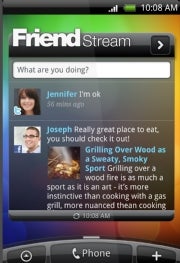HTC EVO 4G
HTC EVO 4G:

Pros
Superb 8-megapixel camera
Gorgeous, responsive display
Cons
4G coverage isn't everywhere
Bottom Line
The
speedy HTC EVO 4G packs in some powerful specs and a variety of
multimedia features into a stylish, minimalist design, but not everybody
will get to enjoy one of its best features--4G connectivity.
Shop for the HTC EVO 4G
HTC EVO 4G: A Multimedia Powerhouse
HTC has struck gold again with the HTC EVO 4G ($200
with a two-year contract from Sprint), which is easily the best Android
smartphone available. The EVO 4G packs powerful specs and a lot of
features in a slick, stylish design. The biggest drawback is that not
everyone will get to experience 4G connectivity, one of the phone's best
features at launch--yet they'll still have to pay for it.
In
addition to the phone's $200 price tag, EVO 4G owners will have to
shell out $70 per month for unlimited data, as well as a mandatory $10
Premium Data add-on for 4G use. Given that only a handful of cities have
WiMax coverage, this strikes me as unfair. Why should a user in, say,
San Francisco have to pay that additional fee if they don't have 4G
available to them?
Minimalist Design
Though
I'm all for recyclable, minimal packaging, the EVO 4G's box is a little
strange. A colleague pointed out that it resembles a tofu container.
Other reviews have remarked that it looks like a microwavable meal. But
really, it's what's inside the box that matters. The EVO 4G comes with
the bare minimum: a Micro-USB cable, a USB wall charger, a 1500mAh
battery, and an 8GB MicroSD card.
Design-wise,
the EVO 4G is a bit imposing with its 4.3-inch WVGA (800-by-480-pixel)
touchscreen, glossy black bezel, and blood-red detailing. Measuring 4.8
by 2.6 by 0.5 inches, the EVO 4G is also a bit larger than your average
smartphone. Even so, it feels pretty comfortable to hold (and my hands
are small), and I was able to use it with one hand without any issues.
Like the HTC-built Nexus One,
the four navigation buttons (Home, Menu, Back, Search) are part of the
display rather than physical keys. This gives the EVO 4G a sleek,
minimalist look. In my hands-on tests, I found the touch-sensitive
buttons quite responsive, as well. The phone also has a much-hyped
front-facing camera, which I'll cover later in this review.
Like
the Nexus One, the EVO 4G has no dedicated camera key on its spine. The
right edge houses the volume rocker. At the top of the phone sits the
3.5mm headphone jack and the power button. At the bottom is the HDMI
port, along with the Micro-USB connector for both data transfer and
charging.
Flip
the EVO 4G over, and you'll find the 8-megapixel camera and dual LED
flash, plus the phone's sturdy kickstand for tabletop video watching.
When you pull out the kickstand, you see the aforementioned blood-red
detailing. Remove the rubberized, matte-black battery cover, and you're
greeted with even more color; the phone's interior and battery cover are
both that same shade of red. HTC pulled the same design move with the
Droid Incredible, as well as with the HD Mini (except that phone's
interior is mustard yellow).
Honestly,
the native Android keyboard isn't my favorite; the keys are too narrow
and tightly packed, and its dictionary isn't always as on-point as the
iPhone 3GS's. For an alternative, however, I recommend downloading the
keyboard app ThickButtons,
which follows a letter-by-letter algorithm to shrink the letters that
you aren't likely to use and enlarge the buttons that you are.
Android 2.1 With Sense
Out
of all of the custom skins for Android, HTC Sense is definitely my
favorite. It is the easiest on the eyes, and it doesn't bog down the
operating system by trying to do too much. The latest iteration of Sense
features Leap, which is essentially an elegant way of handling
multitasking; it's actually a bit reminiscent of Palm's WebOS deck-of-cards visualization.
Pinch anywhere on the homescreen, and you'll jump to seven thumbnail
versions of your open pages. From there, you can go to any of those open
applications or close out of one.
Friend
Stream, HTC's social network aggregator, allows you to view your
friends' status updates, shared links, and pictures all in one seamless
view. Supported social networks include Facebook, Flickr, Twitter, and
others. I find such social network feeds a bit annoying--do I really
need to see everybody's tweets and Facebook status updates all mixed up
together? But I suppose if you're an avid social networker, seeing all
of these updates in one place is useful.
One
feature I found especially cool: You can tap and drag to highlight a
block of text and either look up a word in a dictionary or translate it
via Google Translate.
Along
with the standard Android applications, such as Gmail, Google Talk, and
YouTube, the phone offers HTC's Twitter app (Peep) and its
photo-geotagging app (Footprints). In addition, you get a handful of
Sprint apps, like SprintTV, Sprint Navigation, Sprint Zone, and Sprint
Football Live.
Multimedia Machine
I'm
not really a fan of HTC's Sense music player. Why? The album art
doesn't take advantage of the EVO 4G's large display while the app is in
Now Playing mode; it remains thumbnail-size. The Sense player is
slightly prettier than the dull-as-dirt Android player, but I prefer
iTunes or Palm's WebOS player. Audio sounded good, though, and the
player supports a respectable range of audio and video formats. On
YouTube, you get a feature called HQ, which enables you to watch
better-quality videos (if available). You simply press the HQ button in
the corner of the video, and a crisper, larger video--one that actually
uses the EVO 4G's entire screen real estate--will load. Better yet, no
4G connectivity is needed.
Video
playback via SprintTV was a disappointment, however. The video
stuttered quite a bit, and the sound didn't match up. According to other
reviews I've seen, it wasn't much better over a 4G connection, either.
Superb 8-Megapixel Camera
While
5 megapixels seems to be the standard for high-end smartphone cameras,
the EVO 4G goes a step further with an 8-megapixel camera with a
dual-LED flash. As with the iPhone 3GS,
you can touch to focus on a subject. The camera's user interface is
pretty straightforward, too, and it offers a handful of advanced
controls such as exposure, color, white balance, and various photo
effects.
Photo
quality was impressive, both indoors and out. Colors appeared vivid but
natural, and details looked sharp. My only complaint was that the flash
tended to blow out details and color in indoor shots (see below).
You
can also capture HD video with the EVO's 4G camera. I was really
pleased with how well my videos turned out, though the results don't
hold a candle to those of a 1080p camcorder (see test video below). You
can output your photos and videos in HD quality (720p) via the HDMI
port. Of course, you'll have to purchase an HDMI cable--which is
unfortunately sold separately.
To share videos, look no further than Qik,
an application that will come preloaded on the EVO 4G. One of my
favorite mobile apps, Qik allows you to stream live videos from your
phone to your family and friends, as well as to share them via social
networking sites like Facebook. And, yes, Qik supports HD-quality
videos.
Last
but not least, the EVO 4G sports a front-facing 1.3-megapixel camera
with video recording. This feature, paired with 4G speeds, opens up many
exciting opportunities for app developers. I'm anticipating lots of
apps with integrated video-chat clients.
Imagine being able to play a multiplayer game while video-chatting with
your opponents. Or, what if you could watch a video while
simultaneously discussing it with a friend? The application
possibilities are endless.
4G and Mobile Hotspot
Unfortunately,
at this time we were unable to test the phone's 4G speeds and features,
as 4G coverage has not yet rolled out in San Francisco. For more
information on the advantages of 4G, see "4G Wireless: 20 Questions Asked & Answered." We'll follow up with more testing as soon as possible.
Sprint
says its 4G network delivers peak download speeds that are up to 10
times faster than 3G average download speeds. Though Sprint has been
talking about its WiMax service (provided via the Clearwire network) for
a few years now, we haven't seen many WiMax-enabled devices outside of
laptop cards and modems.
If
you are in a 4G-connected area, you can use voice and data
simultaneously. I'm sure you've seen those Luke Wilson AT&T
commercials, so you know this is a necessary feature. Yes, you can look
up a restaurant while you're on the phone making dinner plans with your
friends (even though that's kind of rude). Really, though, the most
useful purpose for this function is when you're connected to the mobile
4G hotspot: You won't be disconnected if you get a phone call.
With
the built-in mobile hotspot, you can connect up to eight Wi-Fi-enabled
devices, including a laptop, camera, music player, video player, and any
other Wi-Fi-enabled device, to the 4G network. Connecting to the
hotspot is simple: You can access it either by a dedicated icon on the
Launcher or in your Settings menu. You then type in your SSID name, the
encryption type, and your password, and you're good to go. The hotspot
will cost you $30 per month on top of the $80 for the data plan and
Premium Data add-on. Fortunately, there's no cap on data usage.
Solid Performance
We
were able to test 3G performance, and overall I was impressed with how
quickly multimedia-rich pages loaded over Sprint's network.
Additionally, I was pleased with how clear my phone calls were in San
Francisco. A few of my colleagues on the other end of the line noted
that my voice sounded a bit tinny, but my voice was still sufficiently
loud and clear--even while I stood on a busy street corner.
Like the Nexus One, the HD2,
and the Droid Incredible, the EVO 4G runs on Qualcomm's 1GHz Snapdragon
processor. The EVO 4G was pretty speedy in my hands-on tests, even when
I had multiple applications open. Applications launched quickly, too,
though a few crashed on me (Sprint Football Live and Qik were the
offenders).
Though
Sprint hasn't released numbers for talk-time or stand-by time, I found
that I was able to go a full day with moderate data usage without
needing to recharge. 4G connectivity will definitely affect battery
life, however, and we'll update our review once we're able to test it.
The
HTC EVO 4G represents a huge step forward for both the Android platform
and Sprint's 4G network. Unfortunately, it might be a little too ahead
of its time, as 4G is fairly limited here in the United States. Aside
from that issue, the EVO 4G is a winner with its solid hardware,
multimedia capabilities, and speediness. Even if you don't have 4G
connectivity in your city, you'll be pleased with this smartphone. But
don't say I didn't warn you about that additional $10-per-month fee.












0 comments: